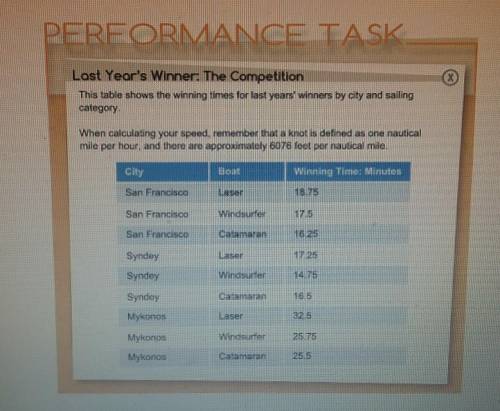
Mathematics, 25.10.2021 16:10, Wemaybewrong
Part IV: Last year's winner (9 points) Your sponsor will need to know how your average speeds compare to the speeds of past winners. In Part IV, you'll find out how to calculate boat speeds in knots (nautical miles per hour).
1. What was the winning time of last year's race for your city and boat? (2 points, one for each leg)
2. Do you know how fast last year's winner was traveling? (2 points)
3. What information do you need to know to calculate last year's winning speed? Remember, the distance traveled (length of the course) is equal to the rate (boat's speed) times the time. (2 points) A nautical mile is 6076 feet. A speed of one nautical mile per hour is a knot. In the next two questions, you will convert a speed in feet per minute to knots.
4. If you travel 1000 feet in 5 minutes, what is your speed in feet per minute? (1 point)
5. What is your speed in knots? Hint: Use the number of minutes in an hour to convert the speed to feet per hour. Then use the number of feet in a nautical mile to convert feet per hour to knots. (2 points: 1 point for finding the speed in feet/hr. 1 point for converting to knots)


Answers: 3
Other questions on the subject: Mathematics

Mathematics, 21.06.2019 14:10, MayFlowers
Determine whether the samples are independent or dependent. upper a data set includes the morning and evening temperature for the lasta data set includes the morning and evening temperature for the last 90 days.90 days.
Answers: 1

Mathematics, 21.06.2019 17:00, SillyEve
In tossing one coin 10 times, what are your chances for tossing a head? a tail? 2. in tossing one coin 100 times, what are your chances for tossing a head? a tail? 3. in tossing one coin 200 times, what are your chances for tossing a head? a tail? deviation = ((absolute value of the difference between expected heads and observed heads) + (absolute value of the difference between expected tails and observed tails)) divided by total number of tosses. this value should always be positive. 4. what is the deviation for 10 tosses? 5. what is the deviation for the 100 tosses? 6. what is the deviation for 200 tosses? 7. how does increasing the total number of coin tosses from 10 to 100 affect the deviation? 8. how does increasing the total number of tosses from 100 to 200 affect the deviation? 9. what two important probability principles were established in this exercise? 10. the percent of occurrence is the obtained results divided by the total tosses and multiplied by 100%. toss the coins 100 times and record your results. calculate the percent occurrence for each combination. percent head-head occurrence: percent tail-tail occurrence: percent head-tail occurrence:
Answers: 3

Mathematics, 21.06.2019 22:30, kpopqueen0
Will mark brainlist what is the slope of the line passing through the points (-2, -8) and (-3,-9)? -7/5-5/71-1
Answers: 2
Do you know the correct answer?
Part IV: Last year's winner (9 points) Your sponsor will need to know how your average speeds compar...
Questions in other subjects:



Mathematics, 04.03.2021 06:20

Mathematics, 04.03.2021 06:20

English, 04.03.2021 06:20




Mathematics, 04.03.2021 06:20

Mathematics, 04.03.2021 06:20







